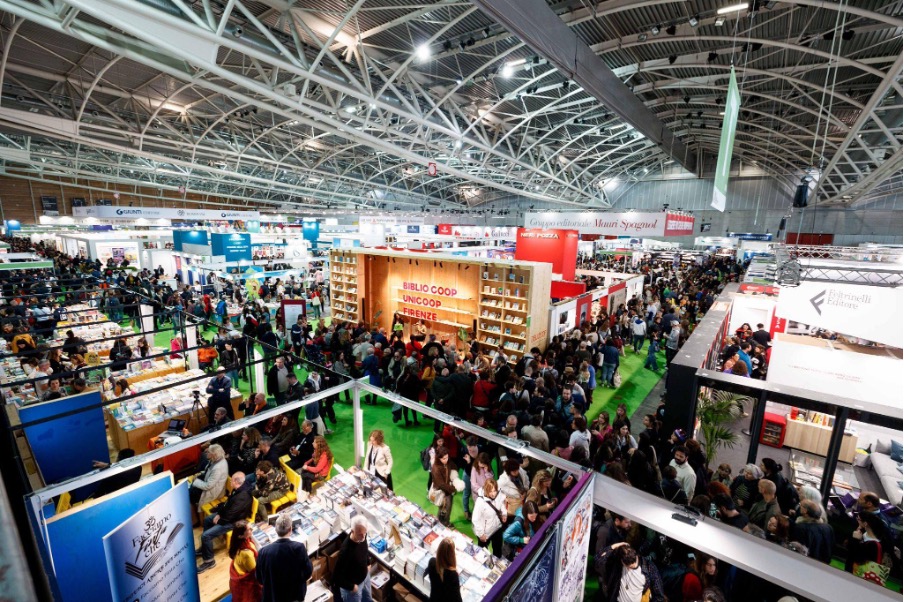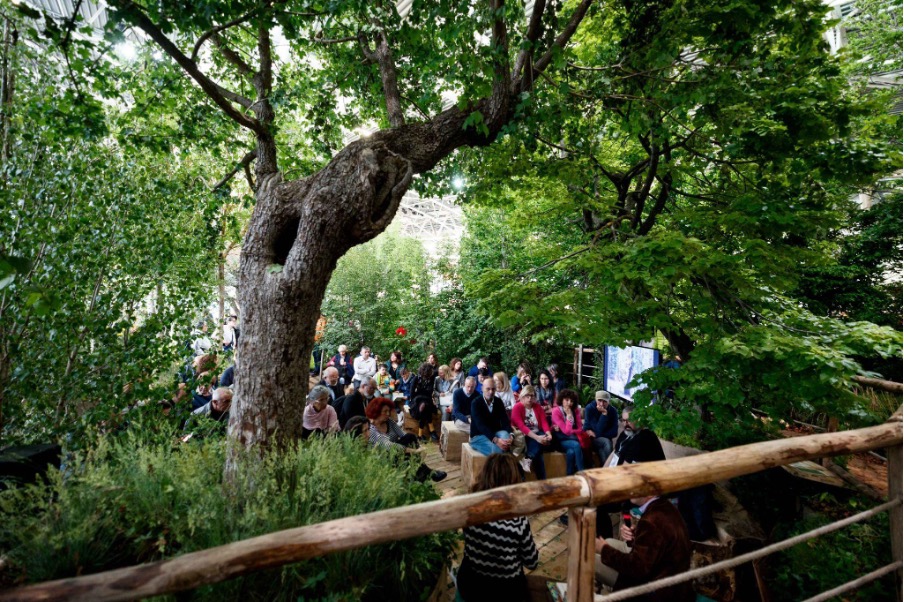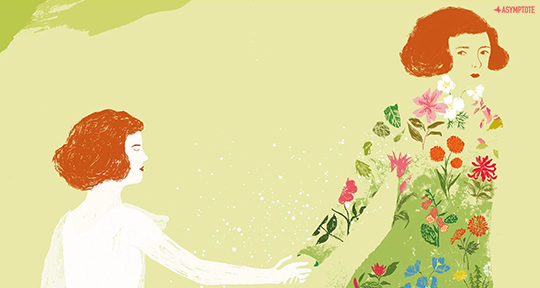The Salone Internazionale del Libro di Torino, or the Turin International Book Fair, was established in 1988 to connect every single participant in the wide-ranging world of literature—from publishers to librarians and, of course, readers. Throughout a large catalogue of readings, performances, conferences, and workshops, the Salone brings in guests from all over the country and abroad to share in the joy of the written world, discuss the current prospects and themes of the industry, and showcase both Italian-language literature and promoting international writing within Italy. This year, Catherine Xin Xin Yu attended the fair on behalf of Asymptote to find out what it has on offer, from migrant literature to eco-writing.
From May 18 to 22, the 35th Salone Internazionale del Libro—the largest annual book fair in Italy—attracted over 200,000 visitors to the Lingotto Fiere exhibition centre in Turin. Over five days of panels, lectures, publisher exhibitions, and literary initatives, perhaps the biggest news story to emerge from the event is an ecofeminist protest led by Non una di meno (Not One Woman Less) and four other Turin-based activist groups against Eugenia Maria Roccella, the anti-abortionist and queerphobic Minister for Family, Natality and Equal Opportunities. Protestors, along with members of the audience who spontaneously joined them, prevented the politician from presenting her newly released memoir in order to demonstrate what it is like to be silenced by the state institutions she represented—which tampers with women’s rights to abortion and surrogate maternity while muddying the water with media misrepresentation and cracking down on protests using police forces. While this peaceful protest was labelled as “anti-democratic” and “unacceptable” by the Meloni government, the Director of the Salone, Nicola Lagioia, defended the contestation as a legitimate democratic act. This is one way in which the Salone provided an urgently needed platform for repressed voices, while opening up a pathway to diversity.
Indeed, the theme for this year’s Salone was “Through the Looking Glass,” featuring over 1,500 kaleidoscopic encounters between storytelling and reality, with notable attempts to bring forward new, alternative perspectives. One such novelty was the focus on colonial legacies and decoloniality. A panel featuring the Somali-Italian author Igiaba Scego, Turin-based Albanian visual artist Driant Zeneli, and Italian crime fiction author Carlo Lucarelli looked at the removal of Italian colonial history from collective memory—drawing attention to the lack of guilt and the myth of “Italiani brava gente” (“Italians, good people”). Many place names in Italy still bear witness its colonial past: visitors in Turin might notice that the final stop of Metro Line 1 is called Bengasi (like the city in Libya); I myself have rented a flat on Via Tripoli and regularly run errands on Via Addis Abeba (like the capital of Ethiopia) and Via Macallè. But these quotidian reminders often go unnoticed, and colonial history is not systematically taught in schools.

At the heart of the discussions on how this silence can be broken are words that “tear apart, resist, and restore,” to quote Jhumpa Lahiri’s preface to Scego’s latest novel, Cassandra a Mogadiscio (Cassandra in Mogadishu). Another panel on decolonisation, featuring the Italo-Somali author Ubah Cristina Ali Farah, the Iraqi author and intellectual Sinan Antoon, and the Filipino trauma journalist Patricia Evangelista, insisted on the importance of reconstructing the lived experiences of victims from a non-Western point of view, and restoring names and humanity to these individuals. Italian, the language of formal education in ex-colonies like Somalia and Ethiopia, is both a line of coloured division and the language of cultural exchange. Recognising the plurality of Italian and using it to foreground individual experiences are both ways to decolonise while writing in the language of the colonisers.
For instance, Igiaba Scego wrote Figli dello stesso cielo (Children of the Same Sky) to talk to her niece and other children about racism and colonialism. Her compatriot Ubah Cristina Ali Farah, who also writes about exile, trauma, and memories of a city erased by war, confessed that: “Language is sometimes insufficient to retell the enormity of what I lived through.” Italian has to be stretched and reworked by diasporic communities to accommodate these migration stories. Since storytelling is a relational process that both shapes and is shaped by the storyteller and the listener, perhaps diasporic literature like Scego’s latest family saga Cassandra a Mogadiscio, Farah’s Le ceneri della fenice e altri racconti (Ashes of the Phoenix and Other Stories), and Il corpo nero (The Black Body) by the second-generation Liberian-Italian author Anna Maria Gehnyei will not only introduce new literary voices, but also shape a new audience. The same goes for the Lingua Madre (Mother Tongue) Literary Contest, which returns to the Salone every year to present a new group of female migrant writers and photographers who tell stories about their roots and identities.
At the same time, non-migrant writers are also using literature to explore the perspectives of Italians who encounter the colonial or postcolonial Other. Carlo Lucarelli investigates the coloniser’s perspective through the character Comissario Marino in Bell’Abissina (Beautiful Abissinian), a historical detective novel set in Fascist Italy. And Virginia Farina based her latest novel Figlia di frontiera (Daughter of the Frontier) on migrants that have braved the arduous Alpine route to reach France, as well as the local Italians who strived to provide them with shelter and the possibility to integrate. Together, this new literary wave shows how Italy is processing its colonial past. Visual artist Dryant Zeneli’s short film The Snake and the Firefly, screened during the Salone, is also an apt fable for colonialism. In the mystical encounter, the snake that swallowed the firefly out of envy for its light did not extinguish the fire—but was burned up and transformed by the encounter.
Diversity could be interpreted in another sense if we zoom out of the human focus and observe the environments we inhabit. Biodiversity and eco-narratives are at the heart of the most beautiful stand in this year’s Salone (according to many visitors, myself included): The Forest of Writers (Il bosco degli scrittori) by Aboca Edizioni. The stand constitutes of a series of lush green biospheres inside the otherwise steel-and-glass exhibition pavilion; the clamour of the Salone recedes as soon as you enter the Forest, where the air is crisp and balsamic, with fresh water murmuring softly in the background. A Mediterranean fig tree greets visitors at the beginning of the footpath, which leads uphill into a cluster of photophilic birches, followed by a mid-altitude deciduous forest with a tree that arches over the stage. From here the path loops downhill, and you can follow the little gurgling creek through the shady coniferous undergrowth to reach the shore of a lily pond and the bookshop. It was tangible, visible, audible and olfactory proof that environmentalism is not necessarily about making sacrifices, but changing focus and embracing a richer range of sensory experiences.

Talks featuring environmental fiction and nonfiction for all age groups were hosted in the Forest and throughout the Salone, and I managed to catch a few on the last day, including journalist and novelist Mauro Garofalo’s presentation of his latest novel L’Ultima foresta (The Last Forest), about a climate exodus caused by droughts and then floods—uncanny timing given the recent floods in northern Italy. In addition to discussing the psychological effects of climate migration, which induce a traumatic loss of “mindscapes” where memories dwell, Garofalo also drew attention to our collective blindness to nonhuman perspectives and to the causal relationship between our immediate actions and their long-term environmental effects. Overall, the rise in ecological narratives reflects an urgent need to “imagine a new narrative habitat” and transition “from ego-fiction to eco-fiction” in order to shift mentalities. This new literary phenomenon, which burgeoned in Italy in the last five years or so, is both refreshing and timely. A success story in using eco-narratives for public education is discussed in the panel called “Recounting the Wolf”. Using innovative theatre and kamishibai (Japanese paper play), conservationists and educators from LIFE WolfALPS and children’s author Maria Bertolini joined forces to teach local residents how they can adapt to the natural return of wolves in the Italian Alps. While most communities initially responded with fear or anger, many have now embraced new ways to farm, live, and coexist with the wolves.
Finally, I looked into diversity in terms of literary forms. The up-and-coming Italian fumetto, a visual-textual form that embraces everything from comics and cartoons to graphic novels and graphic journalism, is moving into the mainstream. By probing “serious” topics while providing entertainment, fumetti are attracting both adults and younger readers. Language and images are different, explained Giacomo Taddeo Traini from BeccoGiallo, a publishing house specialising in comics: “whereas verbal narratives unfold in words, visual narratives function in the white spaces.” This sentiment was seconded by fellow artist-editor-publisher Lorenzo Palloni, founder of the graphic journalism magazine La Revue Dessinée Italia. What was emphasised, however, was not the differentiation between these two mediums, but that both the verbal and the visual are concerned with storytelling, and together they create a multi-layered and flexible medium that appeals to empathy.
But in a field already dominated by Japanese manga, French BD, and American comics, what do Italian fumetti have to offer to international readers? Giacomo shared that Italian comics have absorbed influences from everywhere and used them to its advantage, and that stories drawn from real life tend to engage readers more effectively. Lorenzo pointed out that it is a “medium of the poor” (un medium povero) that can tackle complex topics with minimal financial investment—unlike films, for example. And as the fourth biggest market for comics in the world, Italian artists have an arsenal of expertise, a host of internationally acclaimed artists like Zerocalcare and Igort, a strong focus on rhythm and storytelling, and more narrative freedom compared to comics from France.
So, to wrap up a week of somewhat chaotic but eye-opening events and book-shopping, I treated myself to a fumetto called Tutti autistici? (Everyone Autistic?) by Edo Massa. What is it about? Neurodiversity.
All books mentioned in this dispatch are untranslated recent publications in Italian unless otherwise indicated. Names, titles, and quotes translated by Catherine Xin Xin Yu.
Catherine Xin Xin Yu is a literary and academic translator based in Piedmont, Italy. She works with English, Chinese, Cantonese, and Italian. She holds an MA in Specialised Translation from the University of Bologna, MA in Archaeology of Asia from UCL, and BA in History from UCL. She enjoys reading about nature, gender, indigeneity, and diaspora, and shares bookish thoughts at @Riso.Allegro on Instagram. Her translation of an extract from Cloudland by Wu Ming-yi is published in the Spring 2023 Issue of Asymptote Journal. She is Asymptote’s Assistant Director of Outreach.
Image source: Salone del Libro press kit
*****
Read more on the Asymptote blog:

